Voya Financial Bundle
Who Really Owns Voya Financial?
Understanding a company's ownership structure is crucial for investors and strategists alike. From its roots as ING U.S. to its current status, Voya Financial's journey offers a fascinating case study in corporate evolution. Discover the key players and pivotal shifts that have shaped this financial services giant and its strategic direction.
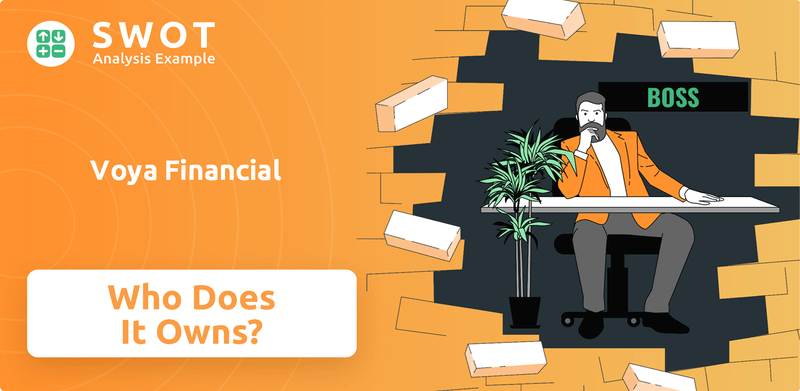
This exploration into Voya Financial SWOT Analysis will uncover the intricacies of Voya ownership, examining its transition from a subsidiary to a publicly traded entity. We'll investigate who owns Voya, detailing the influence of major Voya investors and the distribution of Voya stock among public shareholders. Analyzing the Voya company's ownership structure provides critical insights into its financial performance and strategic focus, helping you make informed decisions in the dynamic financial landscape.
Who Founded Voya Financial?
The initial ownership of Voya Financial, formerly ING U.S., Inc., traces back to its origins as a subsidiary of ING Group, a global financial entity based in the Netherlands. The structure at its inception in 1991 placed the ultimate ownership firmly with ING Group. Therefore, the concept of individual founders with equity stakes, common in startups, doesn't apply to Voya Financial's early days.
During its formative years, all key decisions, including those related to equity and strategic direction, were managed by ING Group. This meant there were no early investors or family members acquiring shares in ING U.S. because it was an integral part of a larger, established global organization. Internal agreements, such as vesting schedules, would have been handled within ING Group's corporate framework, not publicly disclosed for ING U.S. as a separate entity.
The vision for ING U.S. was directly aligned with ING Group's global strategy to grow its presence in the American financial services market, with a focus on retirement, investment, and insurance solutions. There were no initial ownership disputes or buyouts concerning ING U.S. as a distinct entity, considering its status as a wholly-owned subsidiary.
Voya Financial's early ownership was entirely controlled by ING Group.
The company began as a U.S. subsidiary of ING Group.
ING Group managed all equity and strategic decisions.
There were no external investors during the initial phase.
Internal agreements were within ING Group's structure.
The vision was part of ING Group's broader global strategy.
Understanding the early ownership of Voya Financial is crucial for grasping its subsequent evolution. The company's roots as a subsidiary of ING Group shaped its initial structure and strategic direction. The absence of external investors and the centralized decision-making process within ING Group are defining characteristics of this early phase. For more detailed information on the company's current structure, you can refer to an article about Voya Financial.
- ING Group held complete ownership and control.
- No external investors were involved initially.
- Strategic decisions were centralized within ING Group.
- The vision was aligned with ING Group's global expansion.
Voya Financial SWOT Analysis
- Complete SWOT Breakdown
- Fully Customizable
- Editable in Excel & Word
- Professional Formatting
- Investor-Ready Format
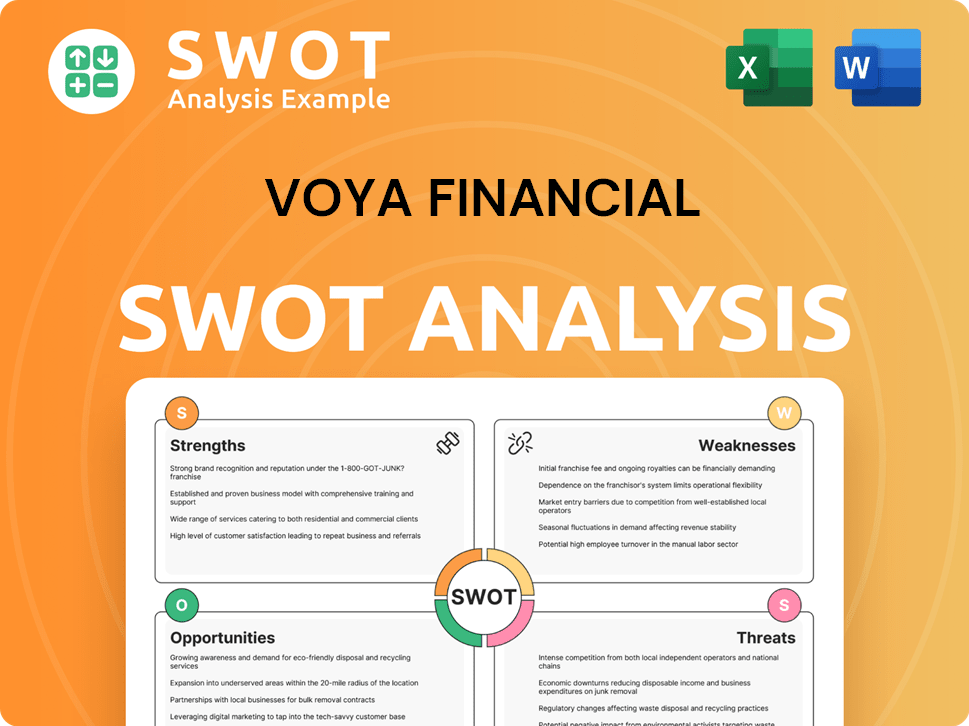
How Has Voya Financial’s Ownership Changed Over Time?
The most significant change in Voya Financial's ownership structure occurred with its initial public offering (IPO) in May 2013. This event marked its separation from ING Group, which gradually divested its stake following a restructuring agreement with the European Commission. The IPO, which saw ING U.S. rebranded as Voya Financial, introduced its shares to the public market, transforming it from a wholly-owned subsidiary to a publicly traded company.
Since the IPO, the ownership of Voya Financial has been largely dominated by institutional investors. This shift has significantly impacted Voya's strategy and governance, subjecting it to greater scrutiny from shareholders and market forces. The company's focus on delivering shareholder value, through its core businesses, is directly influenced by the expectations of its diverse institutional and individual investor base. The absence of a single dominant founder or family ownership means that control is more widely dispersed among its public shareholders.
| Ownership Milestone | Date | Details |
|---|---|---|
| Separation from ING Group | Pre-2013 | Voya Financial was a subsidiary of ING Group. |
| Initial Public Offering (IPO) | May 2013 | Voya Financial became a publicly traded company. |
| Institutional Ownership Dominance | 2013-Present | Institutional investors hold a significant portion of Voya's shares. |
As of the first quarter of 2025, major institutional shareholders include Vanguard Group Inc., BlackRock Inc., State Street Corp., and Capital Research Global Investors. For instance, Vanguard Group Inc. held approximately 11.5% of Voya's shares, and BlackRock Inc. held around 9.8% as of late 2024. This reflects a common trend in publicly traded companies where passive and active institutional investment plays a pivotal role. To better understand the company's approach, you can explore the Marketing Strategy of Voya Financial.
Voya Financial is a publicly traded company, not a subsidiary of a parent company.
- The IPO in 2013 was a key event.
- Institutional investors are the major shareholders.
- Vanguard and BlackRock are significant shareholders.
- Voya Financial is a Fortune 500 company.
Voya Financial PESTLE Analysis
- Covers All 6 PESTLE Categories
- No Research Needed – Save Hours of Work
- Built by Experts, Trusted by Consultants
- Instant Download, Ready to Use
- 100% Editable, Fully Customizable
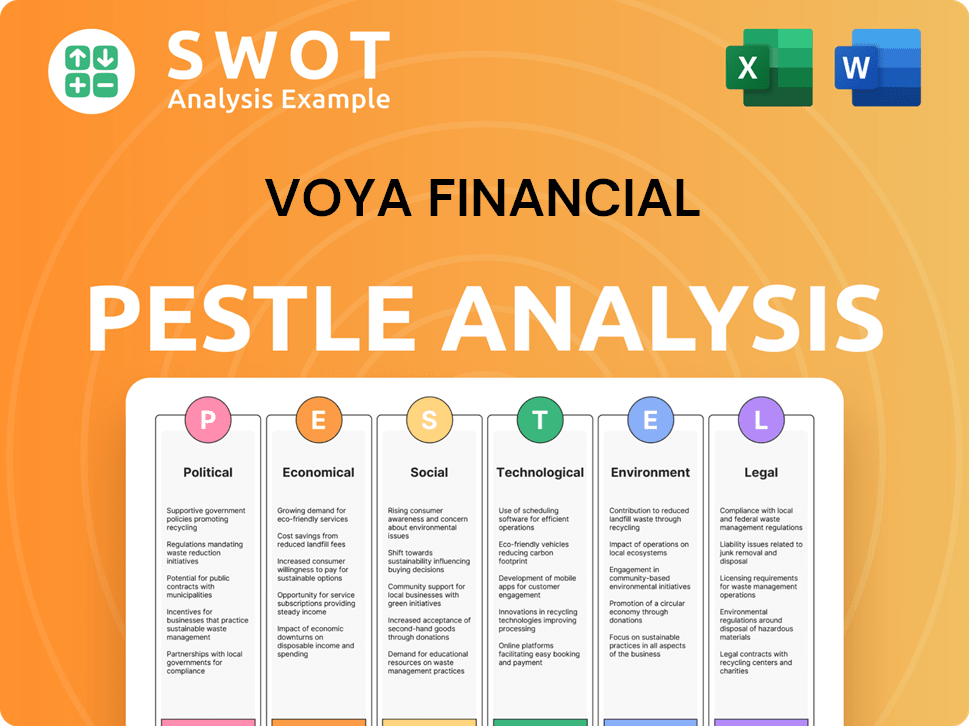
Who Sits on Voya Financial’s Board?
The Board of Directors of Voya Financial, as of early 2025, is structured to include a blend of independent directors and executives from within the company. This structure is a common practice aimed at ensuring robust corporate governance. The board typically includes the CEO and other key executives, with independent directors forming a majority. This composition allows for a balance between internal expertise and external oversight.
While specific board members representing major shareholders are not explicitly identified in public filings as direct representatives, the influence of institutional investors such as Vanguard and BlackRock is significant. These large institutional investors indirectly affect the board's composition through their engagement and voting on proxy matters. This indirect influence underscores the importance of shareholder engagement in shaping corporate governance at Voya Financial.
| Board Member | Position | Affiliation |
|---|---|---|
| Rodney O. Martin, Jr. | Chairman of the Board | Independent Director |
| Christine M. McCarthy | Director | Independent Director |
| David M. Cordani | Director | Independent Director |
The voting structure for Voya Financial adheres to the one-share-one-vote principle, which is standard for publicly traded companies in the United States. There are no indications of dual-class shares or special voting rights that would grant disproportionate control to specific individuals or entities. This approach ensures that voting power is directly proportional to the number of shares held, promoting fairness among Voya investors.
Voya Financial's governance emphasizes transparency and accountability to its shareholders. Decisions by the Board of Directors are focused on maximizing shareholder value and ensuring the company's long-term sustainability. This approach aligns with the interests of its diverse ownership, including institutional and individual investors.
- The voting structure is based on one-share-one-vote.
- The board includes a mix of independent directors and executives.
- Major institutional investors indirectly influence board composition.
- The company focuses on transparency and accountability.
Voya Financial Business Model Canvas
- Complete 9-Block Business Model Canvas
- Effortlessly Communicate Your Business Strategy
- Investor-Ready BMC Format
- 100% Editable and Customizable
- Clear and Structured Layout
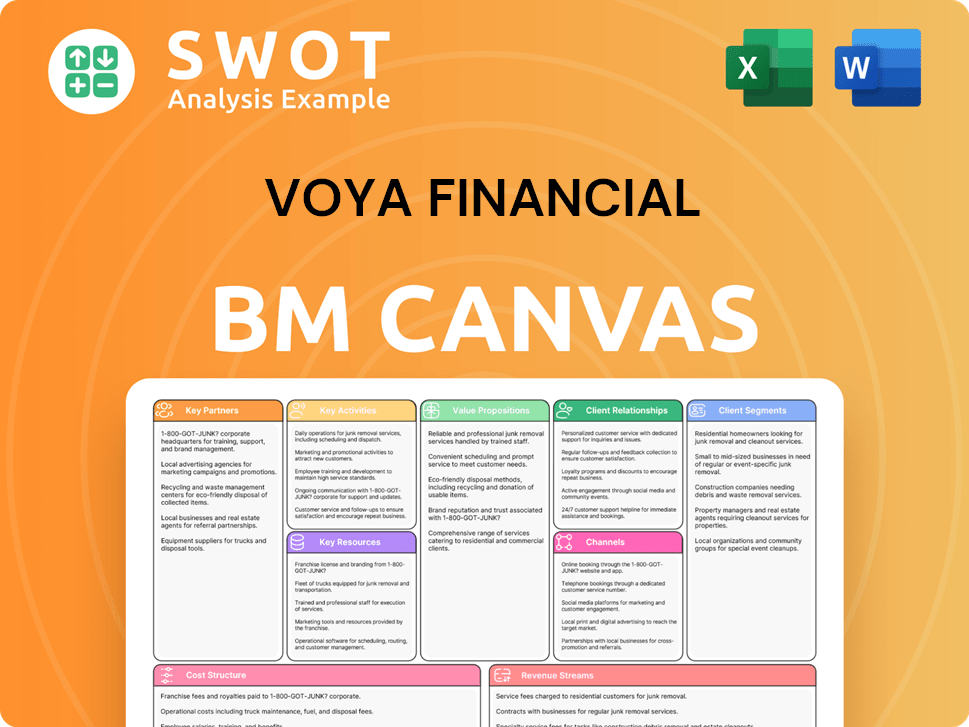
What Recent Changes Have Shaped Voya Financial’s Ownership Landscape?
Over the past few years, from 2020 to early 2025, Voya Financial has been reshaping its business and ownership. A key move has been the consistent use of share buyback programs, designed to give money back to shareholders and boost their returns. In early 2024, for example, the company approved a $1 billion share repurchase plan, showing its dedication to managing its capital effectively. This focus reflects a broader trend in the financial sector.
The company has also made strategic decisions to sell off certain parts of its business and acquire others, to concentrate on its main areas: retirement plans, investments, and employee benefits. A notable move was the sale of its individual life insurance and annuity businesses. These actions, along with the increasing influence of institutional investors, highlight the evolving landscape of Voya Financial's ownership. These institutional investors often consider ESG factors when making investment decisions.
Institutional investors continue to increase their stakes in Voya Financial, leading to a higher degree of institutional ownership. This shift often puts more pressure on companies to perform well and adhere to ESG principles. While Voya Financial doesn't have a founder in the traditional sense, the trend of financial services companies consolidating could influence future strategies. The company's communications with investors, including earnings calls and presentations, often hint at future capital allocation plans, such as more share repurchases or strategic investments, but there have been no recent announcements about privatization or a change in its public listing status.
| Metric | Value (as of Q1 2024) | Source |
|---|---|---|
| Total Assets Under Management and Administration | Approximately $813 billion | Voya Financial Q1 2024 Earnings Release |
| Share Repurchase Authorization (2024) | $1 billion | Voya Financial Press Release |
| Institutional Ownership Percentage | Approximately 85% | Market Data Analysis |
The stock symbol for Voya Financial is VOYA. Investors can track its performance on major stock exchanges. Financial analysts regularly provide ratings and price targets for the stock.
Major shareholders of Voya Financial include large institutional investors. These institutional investors often hold a significant percentage of the company's outstanding shares. Their investment decisions can influence the company's strategic direction.
To invest in Voya Financial, individuals can purchase shares through a brokerage account. Investors should review the company's financial performance and future outlook. Consulting a financial advisor is recommended.
The financial performance of Voya Financial is reported quarterly. Key metrics to watch include revenue, earnings per share, and assets under management. The company's financial reports provide detailed insights into its operations.
Voya Financial Porter's Five Forces Analysis
- Covers All 5 Competitive Forces in Detail
- Structured for Consultants, Students, and Founders
- 100% Editable in Microsoft Word & Excel
- Instant Digital Download – Use Immediately
- Compatible with Mac & PC – Fully Unlocked
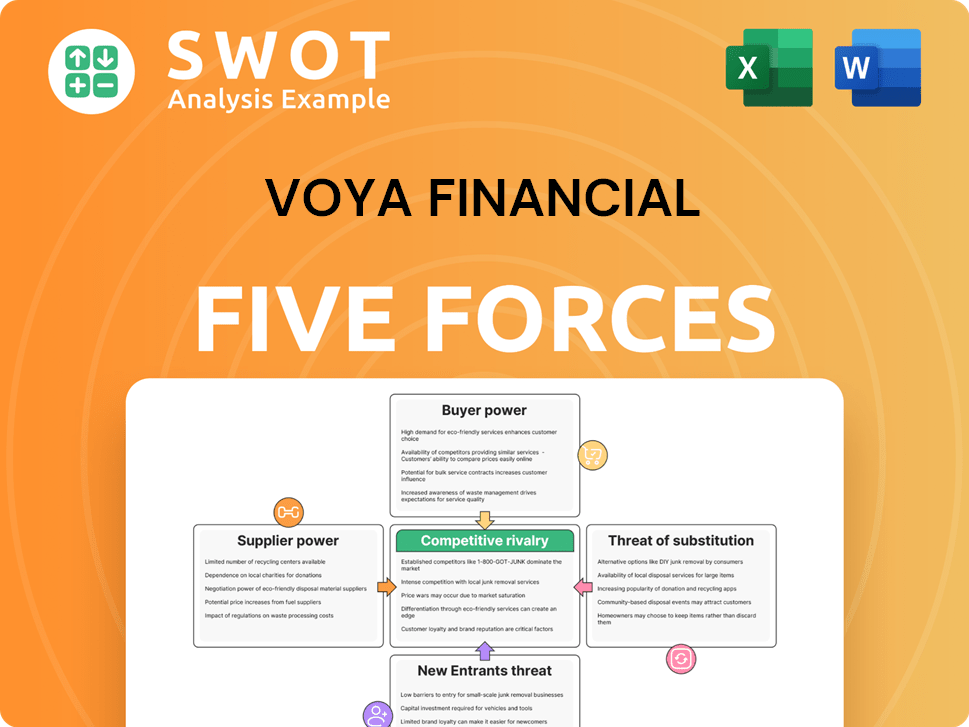
Related Blogs
- What are Mission Vision & Core Values of Voya Financial Company?
- What is Competitive Landscape of Voya Financial Company?
- What is Growth Strategy and Future Prospects of Voya Financial Company?
- How Does Voya Financial Company Work?
- What is Sales and Marketing Strategy of Voya Financial Company?
- What is Brief History of Voya Financial Company?
- What is Customer Demographics and Target Market of Voya Financial Company?
Disclaimer
All information, articles, and product details provided on this website are for general informational and educational purposes only. We do not claim any ownership over, nor do we intend to infringe upon, any trademarks, copyrights, logos, brand names, or other intellectual property mentioned or depicted on this site. Such intellectual property remains the property of its respective owners, and any references here are made solely for identification or informational purposes, without implying any affiliation, endorsement, or partnership.
We make no representations or warranties, express or implied, regarding the accuracy, completeness, or suitability of any content or products presented. Nothing on this website should be construed as legal, tax, investment, financial, medical, or other professional advice. In addition, no part of this site—including articles or product references—constitutes a solicitation, recommendation, endorsement, advertisement, or offer to buy or sell any securities, franchises, or other financial instruments, particularly in jurisdictions where such activity would be unlawful.
All content is of a general nature and may not address the specific circumstances of any individual or entity. It is not a substitute for professional advice or services. Any actions you take based on the information provided here are strictly at your own risk. You accept full responsibility for any decisions or outcomes arising from your use of this website and agree to release us from any liability in connection with your use of, or reliance upon, the content or products found herein.